Key takeaways:
- Restorative justice emphasizes healing and accountability, allowing participants to confront their actions and foster understanding.
- Key moments of empathy and vulnerability during sessions facilitated connections between victims and offenders, shifting perspectives on pain and human experience.
- Active listening and shared stories were highlighted as vital tools for fostering dialogue and reconciliation, transforming personal experiences into collective healing.
- Forgiveness was recognized as a complex, non-linear process, allowing individuals to acknowledge pain while moving towards resolution and peace.
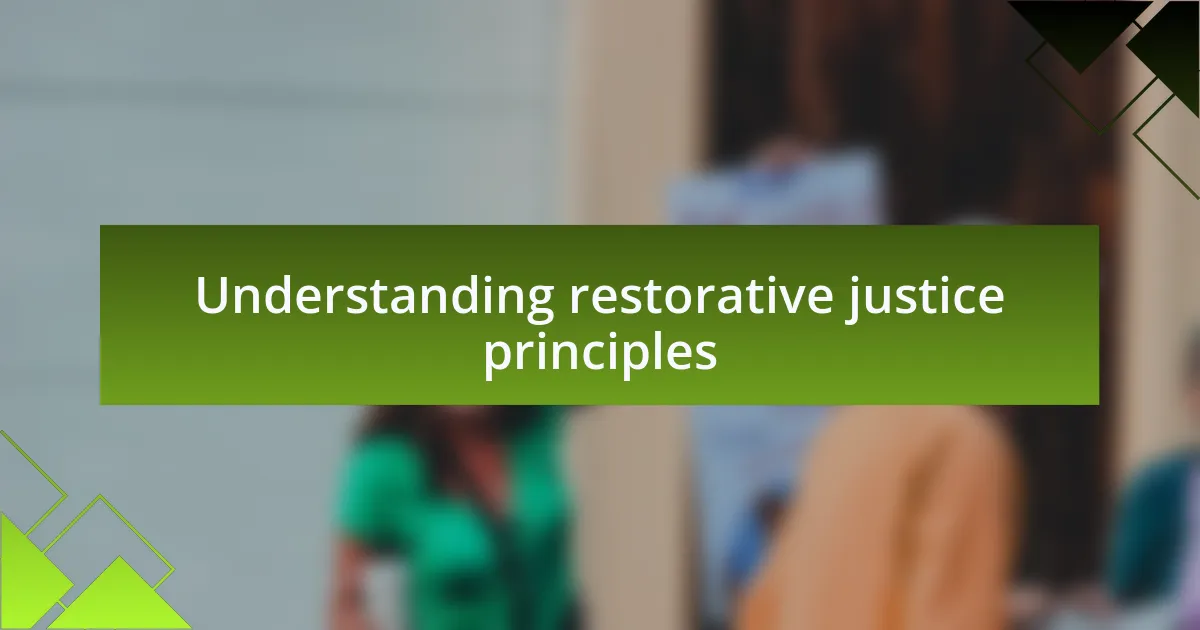
Understanding restorative justice principles
Restorative justice principles focus on healing rather than punishment, creating a space where all parties can engage in meaningful dialogue. I remember sitting in a restorative circle, feeling the tension dissolve as each person shared their story. It really made me question, “What if we prioritized understanding over retribution?”
One key principle is the idea of accountability. Instead of hiding behind walls of shame, participants face their actions and their consequences head-on. I found that grappling with my own mistakes in this context was incredibly liberating. How can we truly learn if we aren’t willing to confront our own truths?
Community involvement is another cornerstone of restorative justice. It’s fascinating to see how bringing in community members can enrich the process. I’ll never forget when a community sage shared wisdom that transformed the way we saw each other; it made me reflect on the power of collective healing. Doesn’t it make you wonder how much more we could achieve by working together in this way?
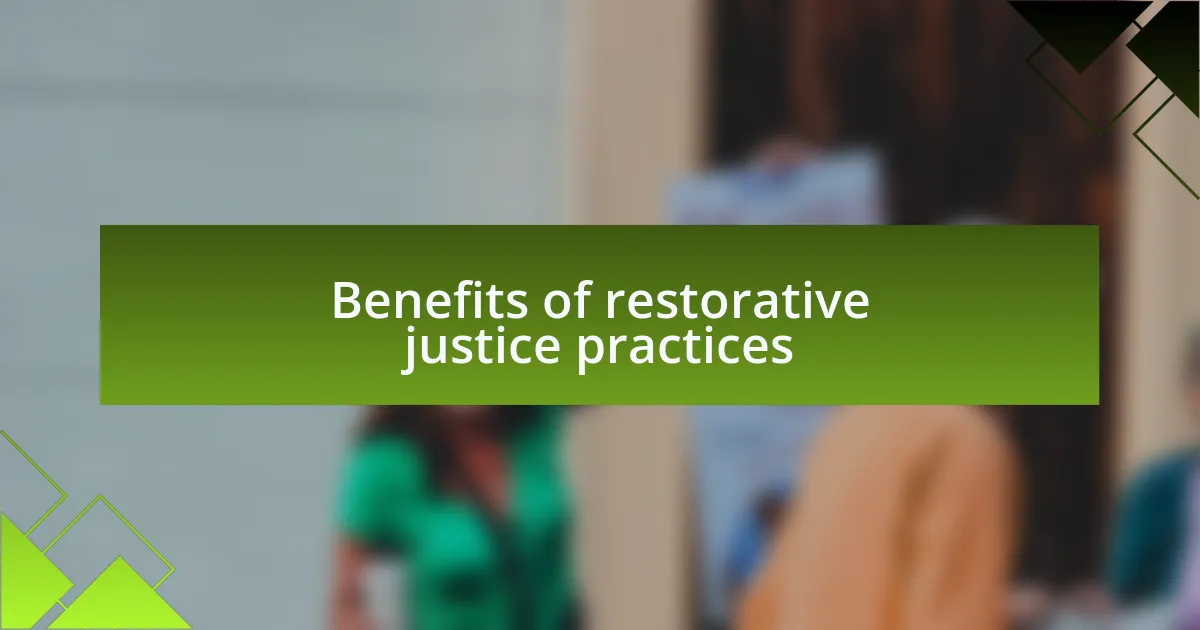
Benefits of restorative justice practices
Restorative justice practices offer profound emotional benefits for all involved. I remember a session where a victim shared how hearing the offender’s perspective allowed her to release years of anger. That moment of empathy was transformative—not just for her, but for everyone present. Have you ever felt the weight lift when understanding someone else’s pain?
Another advantage is the opportunity for personal growth. I’ve seen individuals emerge from these processes with a renewed sense of purpose and clarity. One participant, after acknowledging the impact of their actions, took it upon themselves to mentor at-risk youth. Isn’t it inspiring to think that accountability can lead to positive contributions in society?
Lastly, restorative justice fosters a sense of community resilience. I recall a gathering where survivors and offenders worked alongside each other to create a community garden. This collaborative effort not only beautified our space but also built relationships that had once seemed impossible. Isn’t it remarkable how healing can sprout from the most unlikely of partnerships?
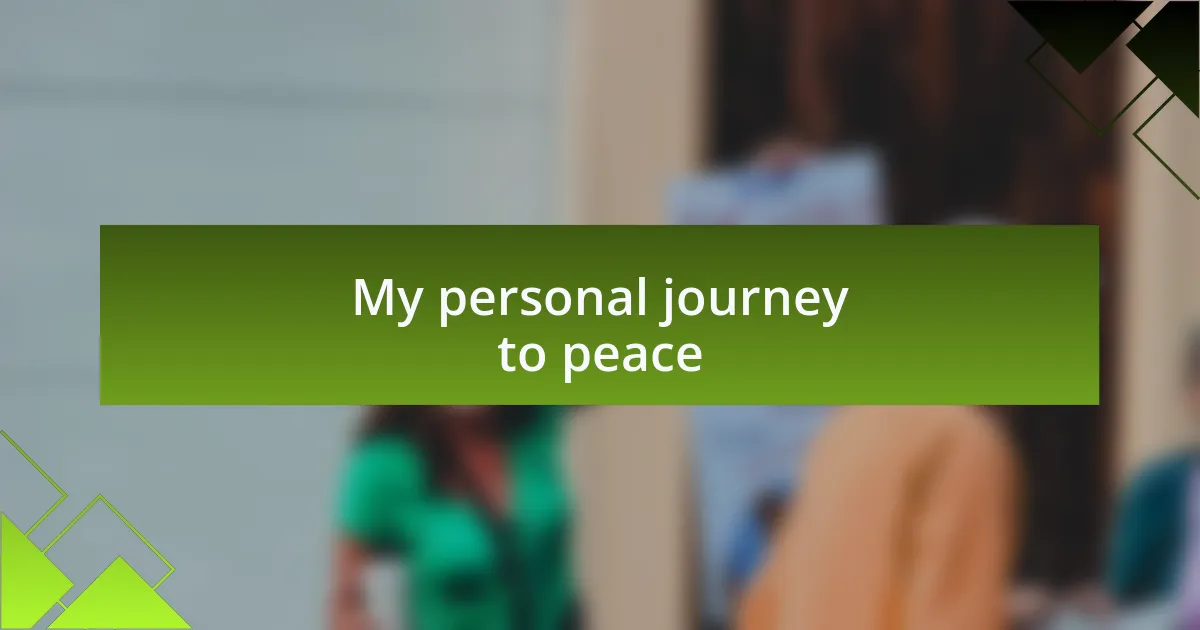
My personal journey to peace
My journey to peace was not a straight path; it was filled with twists and turns. I vividly recall sitting in a circle with other participants, sharing my feelings about the pain my family had experienced. As I opened up, I noticed my heart lightening, like shedding heavy layers I had carried for too long. Have you ever felt a sense of liberation just by speaking your truth?
In one poignant moment, I met someone who had directly impacted my life through their actions. Initially, there was resistance and anger, but as we engaged in dialogue, I discovered a shared humanity that softened my heart. I began to understand their struggles and the circumstances that led to their choices. How is it that bridging these gaps can evoke so much empathy?
Each session felt like a step towards healing, culminating in a profound realization: peace does not mean forgetting the pain; it means finding a way to coexist with it. I remember leaving a restorative justice meeting, overwhelmed by the emotional weight but also filled with hope. The act of sharing stories, both painful and redemptive, opened doors to forgiveness within myself. Isn’t it amazing how deeply rooted emotions can shift towards understanding?
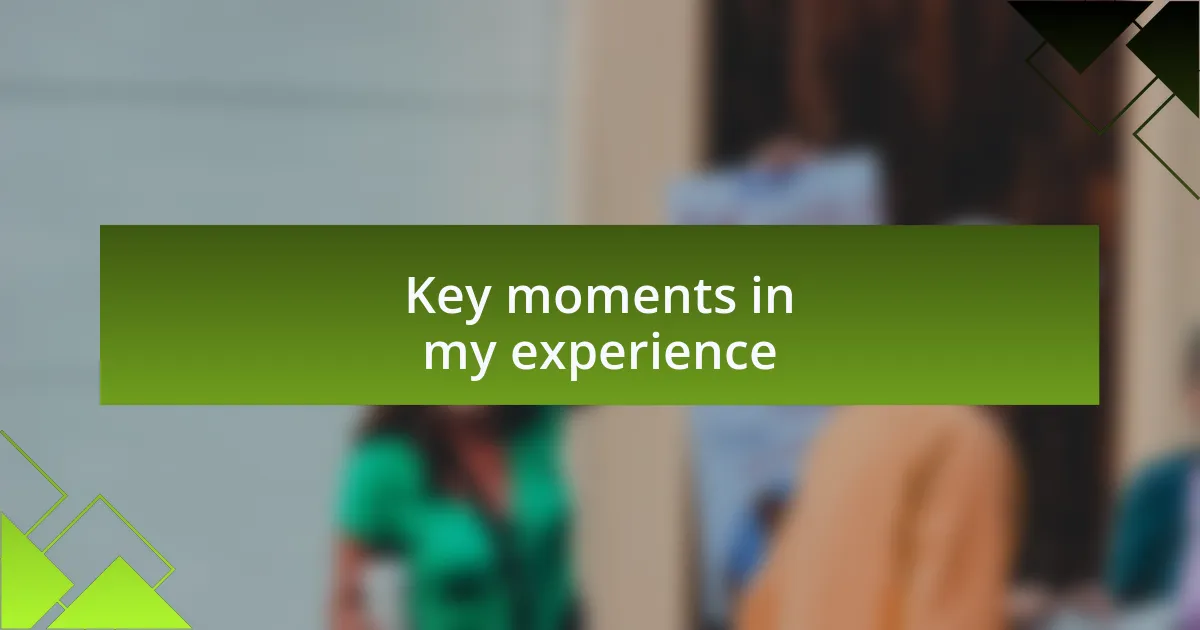
Key moments in my experience
One key moment that stands out in my experience was during a session focused on accountability. I remember a participant sharing how their choices had spiraled, leading to devastating consequences not just for others but also for themselves. Listening to their story, I felt a pang of empathy mixed with disbelief. It made me realize how complex the human experience is—how the intersection of pain and choice can create such far-reaching impacts. Have you ever been confronted with the fragility of someone’s situation and realized your own struggles perhaps mirrored theirs?
Another pivotal moment occurred when we were paired for a one-on-one conversation. It felt intimidating at first; here was someone whose actions had once filled me with rage. But as we spoke, I found common ground in our fears and hopes. I distinctly recall their voice trembling when they spoke about their own family’s pain, which mirrored my own. Isn’t it striking how vulnerability can dissolve walls built on anger?
Finally, I recall the day I decided to write a letter expressing my feelings to the person I had been in conflict with. The process of putting pen to paper felt therapeutic. When I shared it during our meeting, tears flowed freely—not only from me but from others as well. That moment of raw honesty was transformative; it reminded me that peace is often found in embracing our shared humanity. Have you ever experienced the cathartic release of expressing feelings that have long been buried?
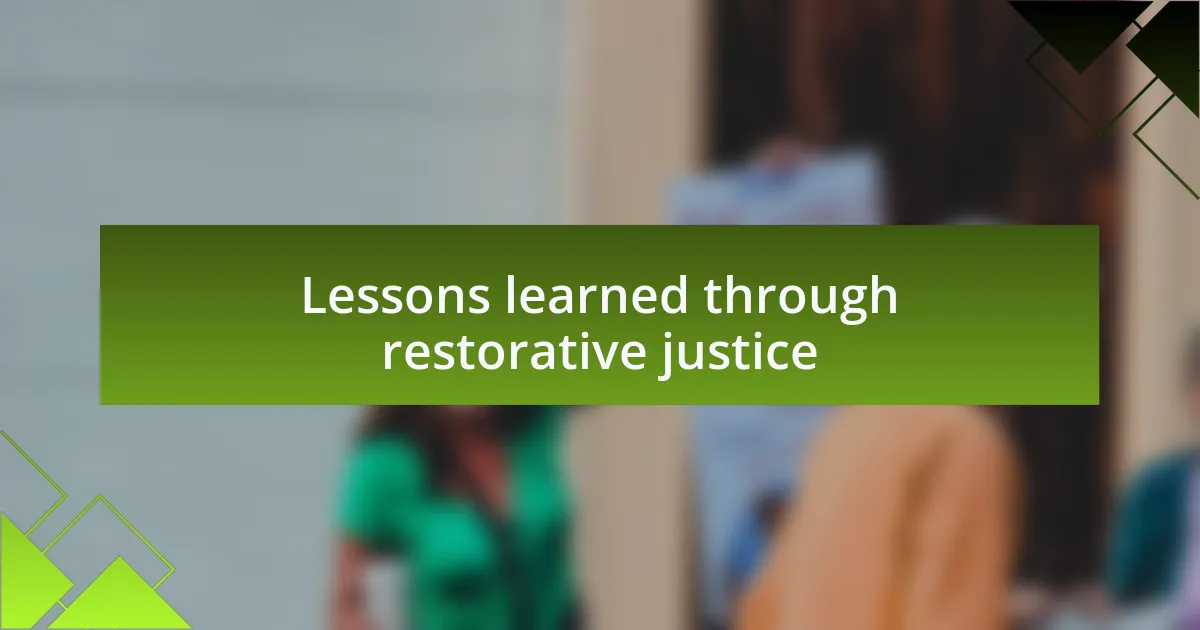
Lessons learned through restorative justice
One of the most profound lessons I learned through restorative justice was the importance of active listening. In our sessions, I discovered that simply hearing someone’s words wasn’t enough; it was about understanding their feelings and perspectives. During one discussion, a participant shared their history of trauma, and as I listened intently, I felt a deep sense of connection. Have you ever realized how much power there is in truly hearing someone? It dawned on me that acknowledging someone’s pain is often the first step in healing.
Another insight was recognizing the transformative potential of empathy. I vividly remember a moment when I responded to a victim’s story with my own feelings of hurt and frustration. Instead of distancing ourselves, we found common ground, which opened up a pathway for dialogue. It made me think: how often do we let our own emotions cloud our ability to empathize with others? In that shared vulnerability, I learned that empathy not only fosters understanding but also creates a safe space for reconciliation.
Finally, I came to understand that forgiveness is not a linear process. During one of our sessions, I confronted my feelings of anger and discovered that releasing them didn’t mean forgetting. I reflected on how many of us hold on to grudges, often thinking it protects us, while in reality, it can chain us to our pain. How freeing it felt to acknowledge that forgiveness can coexist with the memory of hurt. This depth of understanding has reshaped my approach to conflict, pushing me to seek resolution rather than retaliation.
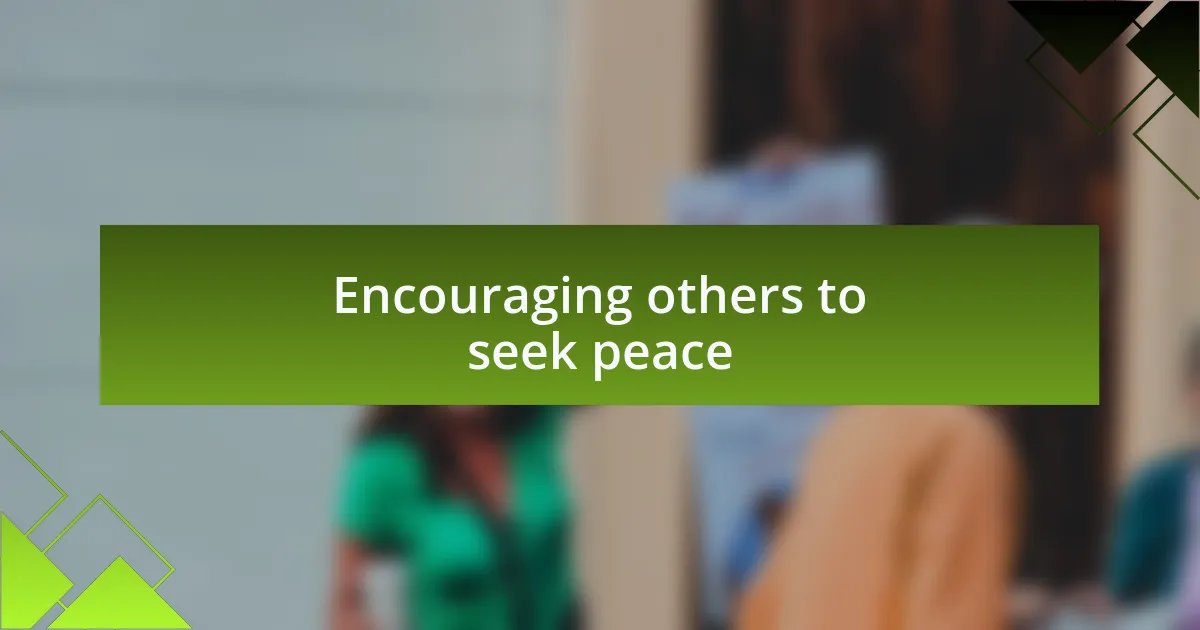
Encouraging others to seek peace
Encouraging others to seek peace starts with sharing our own stories. I remember when a friend confided in me about their struggles with anger stemming from a past injustice. Rather than offering solutions, I shared my experience of finding peace through restorative justice. In that moment, it felt like a weight lifted; my story resonated, showing them that healing is possible and that they are not alone in their journey.
It’s also vital to create spaces where conversations about peace can flourish. I often host small gatherings, inviting people to discuss their experiences of pain and resolution. The atmosphere is charged with vulnerability and honesty, and I’ve witnessed firsthand how discussing our individual paths can ignite a collective desire for peace. Isn’t it remarkable how just sharing space can help dissolve barriers that once felt insurmountable?
Understanding that peace is a personal journey is key in encouraging others. I often reflect on how my path, filled with doubts and emotions, has shaped my view of reconciliation. By acknowledging that peace comes in different forms for everyone, I can encourage friends and peers to embrace their unique process. What if we all recognized that each small step toward understanding can create ripples of change, not just in our lives but in the communities around us?